Physical Address
304 North Cardinal St.
Dorchester Center, MA 02124
The operating room (OR) is a dynamic environment characterised by multilayered social interactions, unpredictability, low tolerance for mistakes and high expectations. The orthopaedic OR is exceptionally dynamic, with operations on patients of all ages from neck to toe with tools varying from bone saws to arthroscopes, drills and more. The variability of orthopaedic surgeries mandates exceptional care and planning be taken before and during procedures. Although all orthopaedic operations require diligent preoperative, intraoperative and postoperative planning, especially meticulous attention to detail must be given by the orthopaedic surgical team (OST) while preparing for complex knee procedures.
The result of deliberate OST preparation includes restored knee function, operative efficiency and a financially stable practice. Lack of optimal preparation can result in the opposite: Wrong site, procedure, patient, or side errors are just a few complications that arise as a result of inefficient preparation and teamwork within the OR. Pertaining to complex knee operations, complications can include iatrogenic vascular and nerve injuries, compartment syndrome, tourniquet-induced arterial thrombus, complex regional pain syndrome and more. These risks are inherent to all knee procedures, and improper team preparation increases these risks and causes poorer outcomes for patients. Furthermore, ineffective teamwork and inefficiency in the OR predispose to a greater likelihood of adverse events and operative errors regardless of the complexity of the procedure. , ,
One may believe that advances in orthopaedic training and operative technique have confined these errors to the past. Unfortunately, this is not the case. Even teams that have the right mix of skill, experience and access to resources may still suffer disastrous breakdowns in coordination because of miscommunication, conflict, different equipment or lack of preparation. Specifically within orthopaedics, operative errors are most commonly related to communication and equipment failures and most commonly involve operations on the hand or knee. , Although improving operative teamwork and efficiency is crucial for all operative teams, research suggests that improving operative teamwork within the OST is especially crucial because knee procedures result in a disproportionately large number of orthopaedic operative complications.
The aim of this chapter is to characterise orthopaedic OR efficiency and briefly discuss factors that illustrate the importance of efficient teamwork and effective usage of orthopaedic ORs. Then the OST is defined and each member’s role analysed and elaborated on. Finally, optimal OST preparation for complex knee procedures is discussed.
The OST is an action team, which can be defined as ‘a team in which members with specialised skills must improvise and coordinate their actions in intense, unpredictable situations’. Surgeons, as leaders of action teams, have an obligation to create a positive working environment and effective surgical teamwork that enhance the performance of their team and improve outcomes for patient safety. , Said more simply, surgeons must be effective team members, decent human beings and leaders to achieve optimal outcomes. Modern healthcare has evolved in that it is virtually impossible to surgically treat a patient in isolation; interprofessional teams are composed of surgeons, anaesthesiologists, surgical technicians, nurses and other team members, all of whom play vital roles when treating patients. Although coordinating patient care across a spectrum of different disciplines can be difficult, multidisciplinary teams have been shown to limit adverse events, improve patient outcomes and add to patient and employee satisfaction. Effective and efficient teamwork within surgical teams is crucial for a practice’s financial stability, patient outcomes and employee culture within the OR.
The OR is the financial nexus for many hospitals and health systems, accounting for upwards of 40% of costs and 60% to 70% of revenue. Rising healthcare expenditures, alongside an average operating room cost of US$62 per minute, have pressured all health systems alike, whether private practice or academic or community institutions, to find ways to manage these expenses. , , Efficient utilisation of the OR can produce a ‘sink or swim’ effect, because the financial implications of how ORs operate often dictate the financial health of their respective hospitals and practices. Furthermore, with increased healthcare-associated costs, many health systems are trying to limit financial burdens now more than ever.
Surgical cost reduction is especially apparent in orthopaedics because these surgical procedures are among the highest of healthcare expenses. For instance, it has been estimated between 60,000 to 75,000 15 ACL reconstructions occur annually in the United States; the average cost for an uncomplicated anterior cruciate ligament reconstruction (ACLR) is estimated to be US$24,707. Total knee arthroplasties are a significant contributor to orthopaedic cost and revenue and are projected to increase by as much as 673%, to nearly 3.5 million arthroplasties per year by 2030. The aforementioned costs are for uncomplicated orthopaedic procedures; complications such as surgical site infections and graft and implant failure can cause these costs to rise even higher. The rising number of procedures and costs associated with each orthopaedic procedure make OR teamwork, preparation and efficiency especially important.
‘First, do no harm’ is a mantra all physicians strive to implement in their practice. Although surgery allows for lifesaving and lifechanging outcomes for patients, the OR always comes with an inherent risk. A 2013 analysis suggested that in the US there are between 210,000 and 400,000 deaths per year attributable to medical errors. By specialty, research has demonstrated that adverse events in orthopaedics (1.2 per 10,000 cases) occur in frequency second only to ophthalmology (1.8 per 10,000 cases). Surveyed orthopaedic specialists reported that the vast majority of their medical errors and adverse events occurred during surgery, most often classifying errors as equipment related or communications related. Interestingly, a commonly reported equipment-related error during orthopaedic procedures was that equipment was not properly prepared or present in the OR, suggesting a root cause of lack of communication was responsible for a majority of medical errors in orthopaedics.
Effective communication and teamwork in the OR can prevent medical errors, improve outcomes and enhance the culture in an operating room. , , , Some researchers have categorised OR teamwork and cooperation, leadership and situational awareness to fall under ‘nontechnical skills’, which must complement the technical skills that surgeons must possess for a successful operation to take place. Plenty of quality improvement campaigns are created aimed at improving these nontechnical skills and minimising errors in the OR, one commonly being the surgical time-out. The surgical time-out ensures agreement on the correct patient, procedure, side, site, availability of implants/special equipment and correct patient position. , , , Surgical safety checklists ( Fig. 39.1 ) have also been implemented to ensure items such as medications, marking of the operative site and equipment are all prepared and ready before surgery. Surgical time-outs and multidisciplinary checklists have significantly decreased patient complications, while also fostering ‘good team behaviours’ such as information sharing and briefing. , Research has demonstrated that when surgical teams exhibit infrequent team behaviours, patients are more likely to experience death or a major complication.
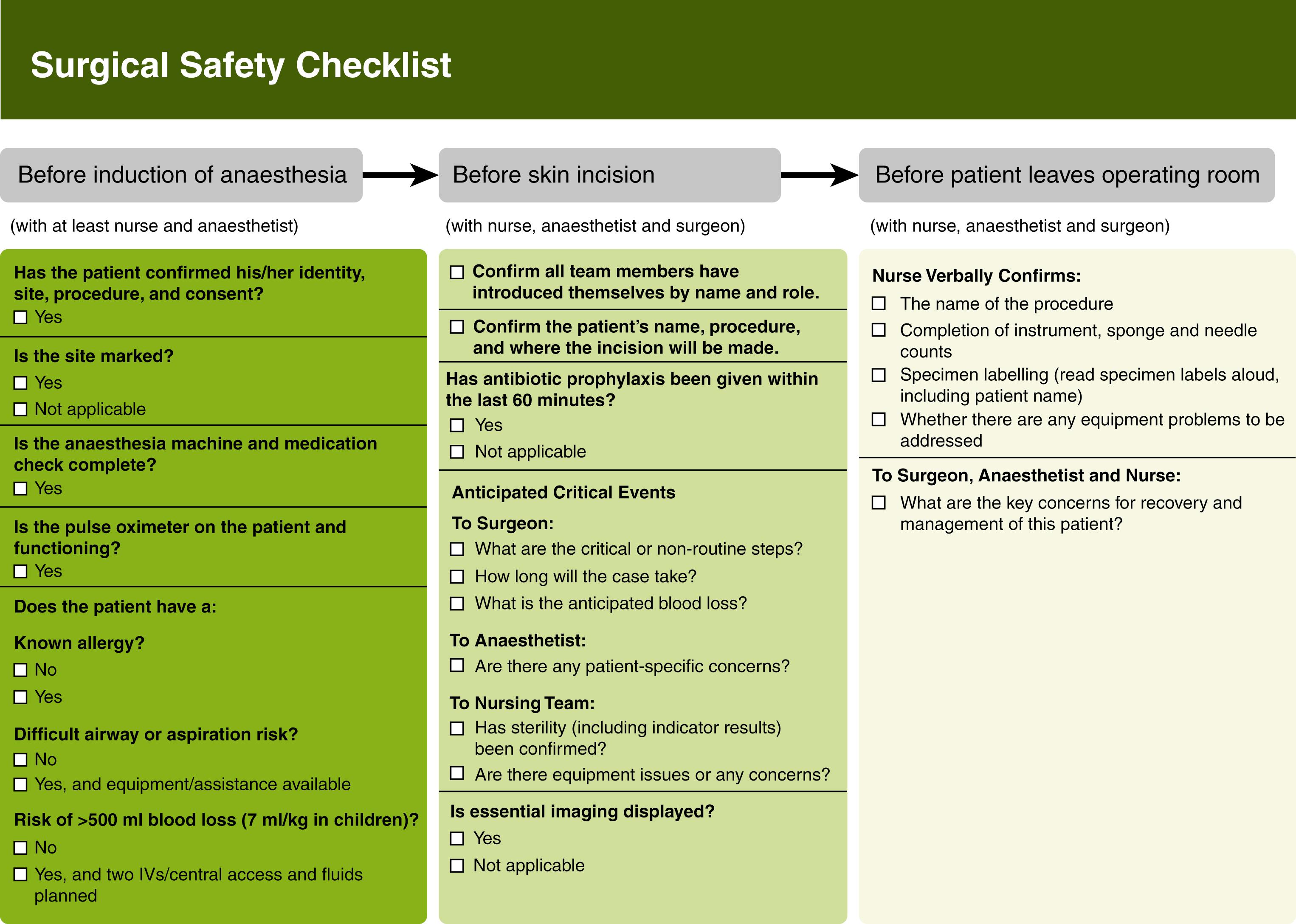
The OR is a mentally and physically demanding environment juxtaposed at the intersection of interdisciplinary teamwork, cutting edge technology and high-risk procedures where errors are extremely costly. The OR environment is challenging enough as is and becomes even more challenging if the composition of surgical teams is not consistent. Team inconsistency has the potential to propagate a negative cycle that makes it difficult for OSTs to properly prepare for complex orthopaedic procedures ( Fig. 39.2 ). Surgeons have detailed the desire for more consistency in team composition, and research has detailed that dedicated OSTs are more efficient and have lower turnover time compared with nondedicated surgery staff. ,
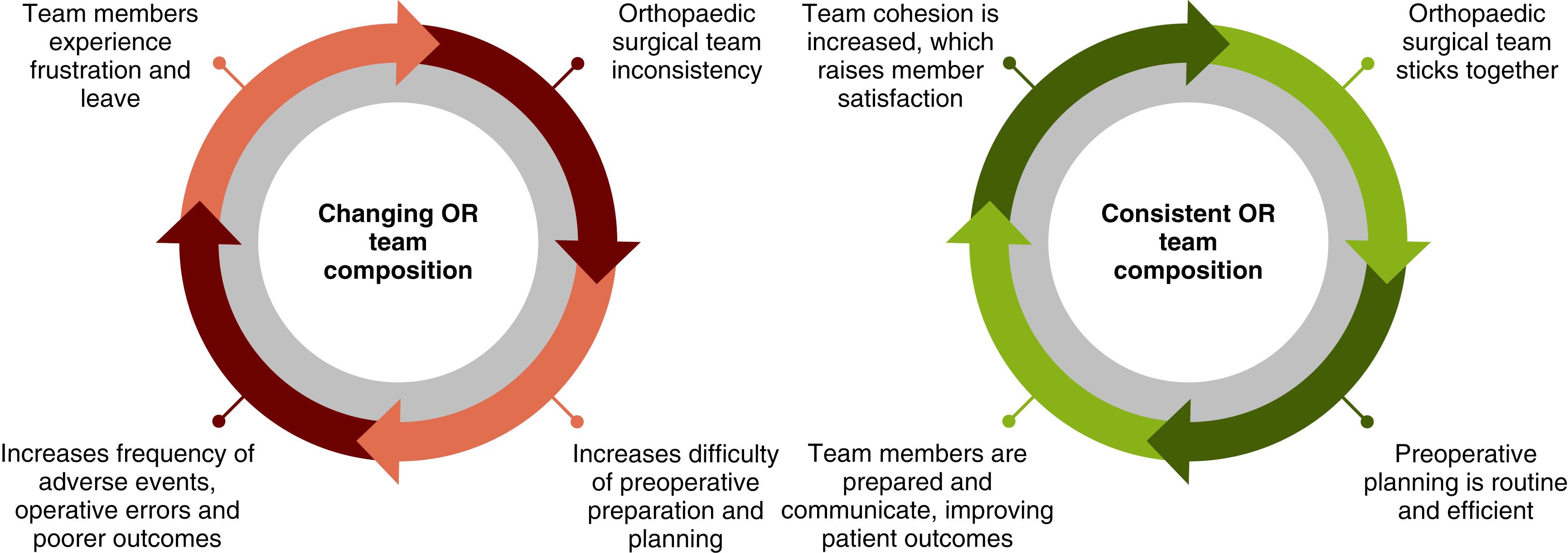
As stressors within the OR precipitate increased staff turnover, team members depart and team composition changes, which has been linked to poorer outcomes. Unsurprisingly, which members of the surgical team depart is largely dependent on how satisfied they are with their job. Team members with low job satisfaction may view the challenges faced daily as exhausting and experience burnout, whereas satisfied employees (i.e., content and well-appreciated team members) may be motivated by these same challenges to adapt and excel. , With that said, job satisfaction is a key determinant of the composition and therefore the consistency and effectiveness of the OST.
Increased job satisfaction has been demonstrated to be one of the results of effective teamwork and communication within the OR. Nurses and surgical technicians have referenced that effective teamwork greatly influenced the general atmosphere of the OR, increased their confidence within the OR and made them more likely to speak up when they felt it was necessary. Surgical team members also stated that the work atmosphere of the OR was most often determined by the surgeon, further emphasising the importance of surgical leadership and teamwork within the OR. 26 As a result of enhanced teamwork and communication, continuity of the OST improves operating efficiency, enhances patient outcomes and elevates job satisfaction. Preparing surgical teams for quick and efficient procedures is much easier when teams are familiar with one another, stick together and can create a positive feedback cycle, improving preparation for future operations.
Although the surgeon leads and is ultimately responsible for the happenings and outcomes in the OR, he or she relies on an interdisciplinary team to operate successfully and efficiently. , This team traditionally includes, but is not limited to, other physicians, registered nurses (RNs), surgical technologists and physician assistants (PAs) to successfully operate in the OR ( Fig. 39.3 ). Furthermore, although the core of the surgical team can traditionally be defined by those who are physically present in the OR while the operation is ongoing, a case can be made that a ‘nontraditional team’ exists that includes ancillary support staff such as scheduling/administrative, custodial and sterilising services. , These roles, although not directly involved in the OR, affect perioperative care and workflow and are pivotal in promoting a safe, efficient OR and minimising delays. Operations cannot proceed without clean ORs, sterilised equipment and administrative oversight and organisation, so team members who fulfil these roles are a vital link in the chain of OR efficiency. In the following sections each team role on the OST will be defined and specific preparation considerations for each role discussed.
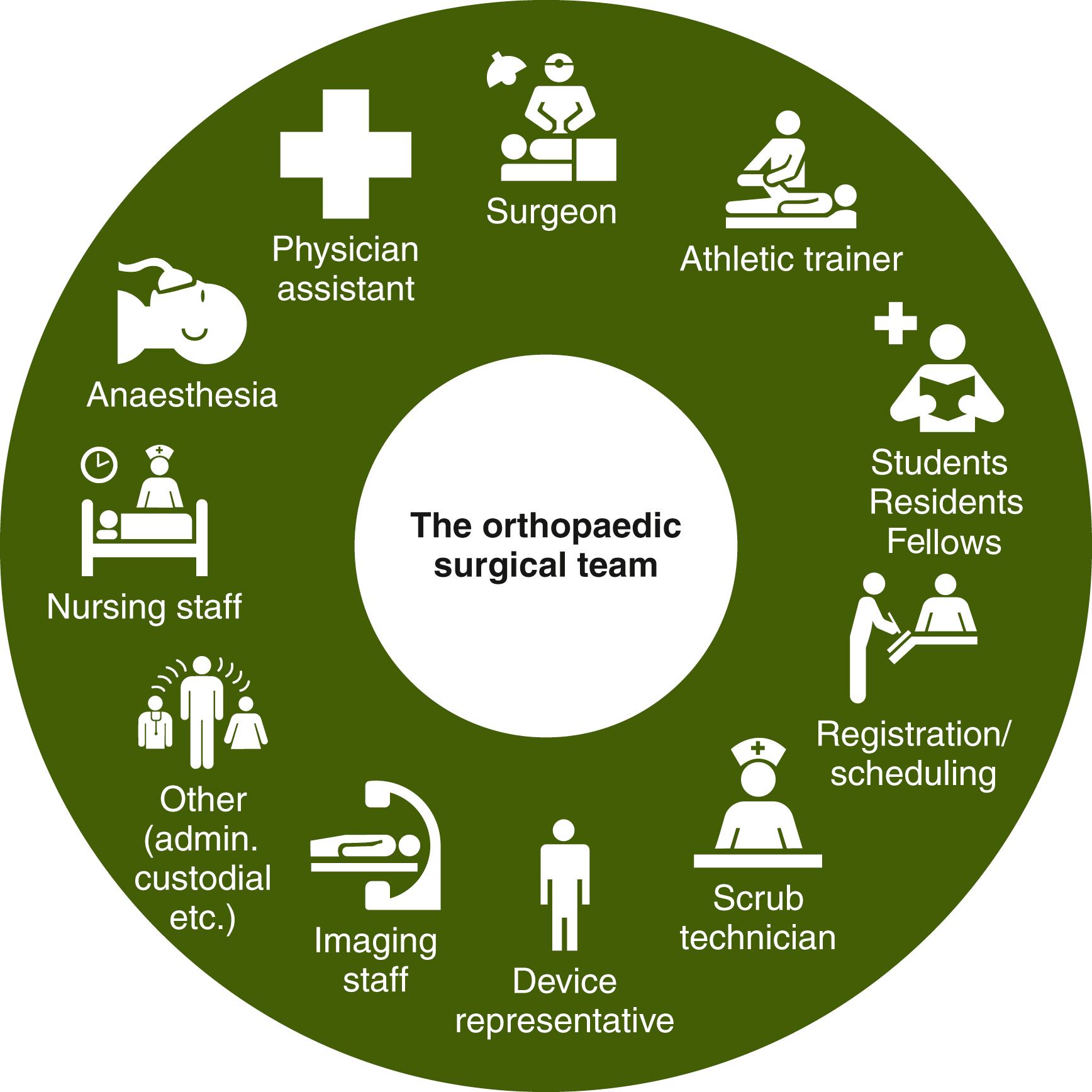
The attending orthopaedic surgeon is chiefly responsible for the happenings and outcomes in the OR. Surgeons dictate the tone and atmosphere in the OR, and effective surgeons must foster a safe interpersonal climate that encourages appropriate teamwork and communication. No matter how complex operations are or what difficulties are encountered, it is never acceptable for surgeons to throw tools, belittle staff or have uncontrolled outbursts within the OR. Having the technical skills to complete complex operations is not a justification or pass for such behaviours.
Beyond the technical skills necessary for completing complex knee procedures, nontechnical skills are necessary to lead and interact with their surgical team respectfully, as decent human beings. These nontechnical skills include but are not limited to communication, preparation, partnership and teamwork. The surgeon must ensure the entire team is adequately prepared to carry out the planned operation, prepare for anticipated complications and improvise when necessary. Surgeons must communicate when they feel the team is not adequately prepared to carry out an operation or when they are not confident with certain aspects of the procedure themselves. If this is the case, then consideration should be given to refer the patient elsewhere to ensure the best patient outcomes.
PAs contribute to the OST while supervised by attending surgeons. Hepp et al. examined the role of a PA on the OST and found PA involvement has been shown to minimise a surgeon’s time spent outside of the OR while maximising the number of surgeries able to be completed in a day. Compared with before a PA was included on the OST, the same OST that included a PA witnessed a 30% increase in the number of patients seen within the first year of adding a PA. PAs play key roles on OSTs both within clinic and intraoperatively. As members of the OST, PAs may perform duties such as removing hardware, bracing, casting and splinting patients, tissue and graft preparation ( Fig. 39.4 ), injection of joints, wound closure and more. Specific to complex knee procedures, preoperatively it is vital for PAs to meet with their supervising surgeons to ensure that the correct approach, anticipated complications (such as screw stripping during hardware removal) and potential necessary improvisations are understood.
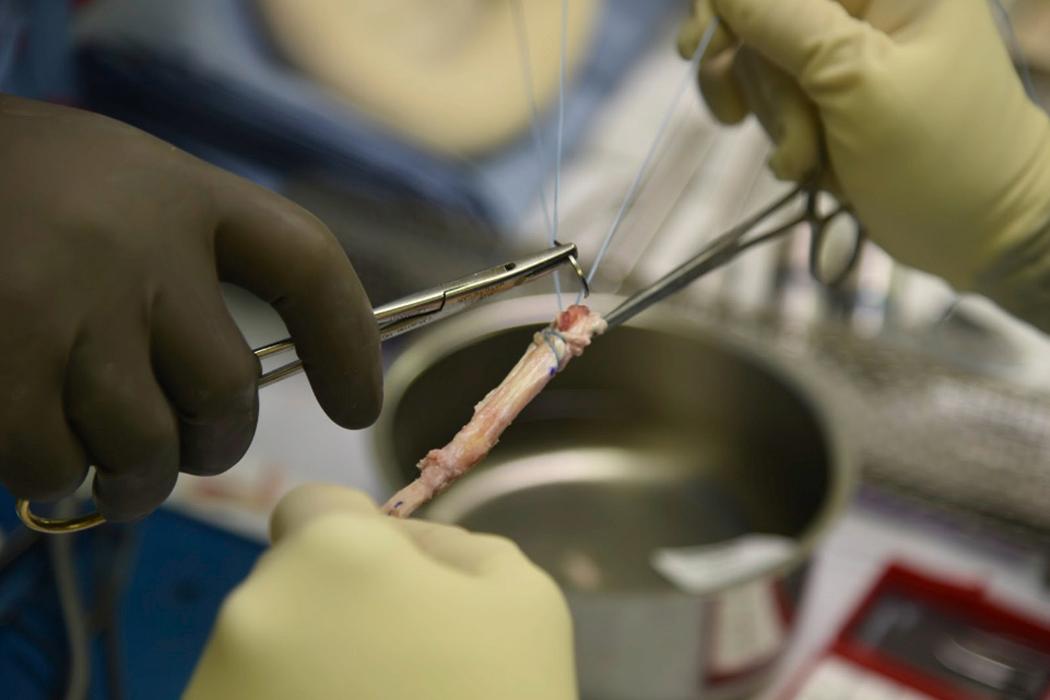
Research has supported the role of the certified athletic trainer (ATC) within the operating room as a member of the OST. , ATCs often seek supplemental credentials, such as becoming a certified orthopaedic technologist (OTC), to obtain scrub privileges to become qualified to work within the operating room. Every facility may have unique standards of operation, so ATCs should consult with the attending surgeon and management to determine which credentialing is necessary for them to be able to work within the OR. Once credentialing is completed, ATCs can complete a variety of tasks within the OR under the direction of the attending orthopaedic surgeon. The role of an ATC in the OR shares a lot of overlap with the PA, with the exception of prescription privileges. Because of the integrated nature of the ATC within the OST, ATCs must be included in preoperative planning and preparation.
Anaesthesia personnel are tasked with managing pain and care of the surgical patient before, during and after surgery. Anaesthesiologists are physicians who may oversee surgical cases directly or manage a team of certified registered nurse anaesthetists (CRNAs) who oversee cases individually. Anaesthesiologists are vital team members in administering nerve blocks (often guided with ultrasound), allowing for complicated procedures that formerly required in-patient hospitalisation to manage postoperative pain to be completed on an outpatient basis. Nerve blocks (which within orthopaedics most commonly target the adductor canal and sciatic and femoral nerves) have been shown to decrease the postoperative length of stay in recovery, decrease perioperative opioid use and increase patient satisfaction. Therefore blocks should be considered when possible for postoperative pain control for complex knee procedures. ,
One method that may help anaesthesia personnel is a dedicated ‘block room’ where procedures take place. Chazapis et al. found that having a dedicated block room for nerve blocks decreased the amount of time patients needed to spend in the preoperative area by 17 minutes per case, increasing operative efficiency. Beyond nerve blocks, anaesthesia team members should ensure general anaesthesia, antibiotics and other special requirements (e.g., blood products for haemophiliac patients) are stocked and ready as part of preparing for orthopaedic procedures.
A surgical technician, also called scrub technician (ST), works with the operating team to prepare the OR, maintain a sterile field and ensure surgeons have timely access to equipment throughout the operation. For each procedure, STs prepare and organise pertinent sterile equipment, which must be rapidly accessible intraoperatively ( Fig. 39.5 ). Regarding complex knee procedures, effective STs anticipate when surgeons will need drills, screws, blades, sutures and other equipment and readily prepare such equipment as the operation progresses. Delays in providing this equipment, difficulties in maintaining a sterile field and lack of communication with other members of the team cause consequences that directly affect the efficiency and outcomes of complex knee procedures. Hence STs must be briefed and able to access information regarding patient operations well in advance to ensure adequate preparation for procedures.
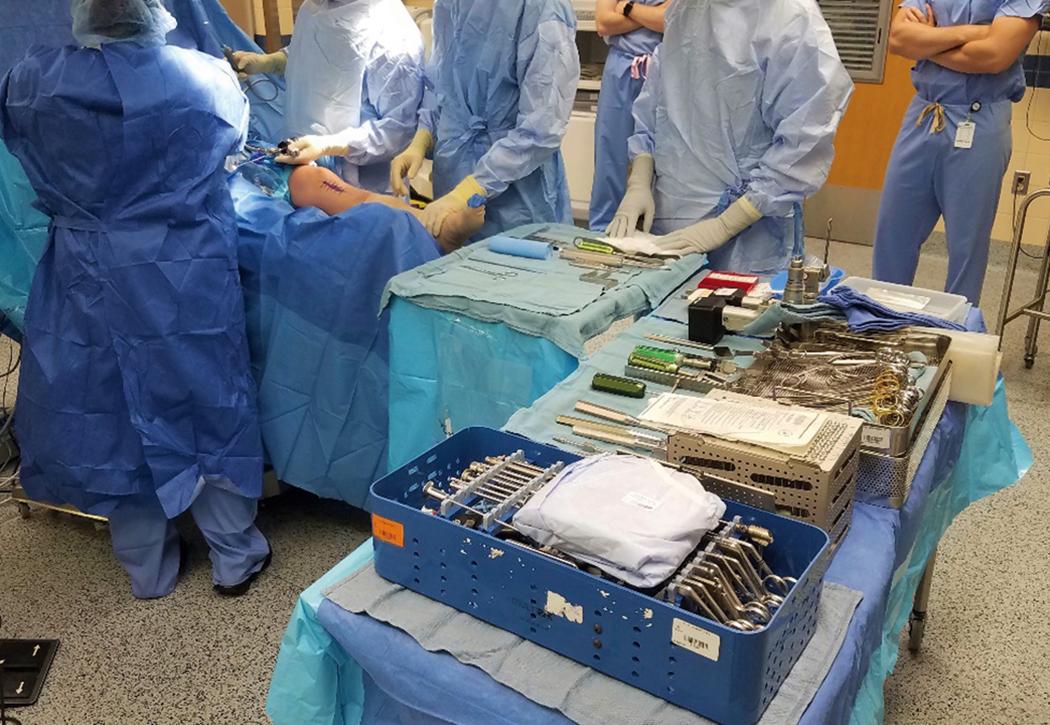
RNs play key roles on all healthcare teams, and the OST is no exception. Within the OR, an RN may practice as a circulating RN or may achieve additional certification to become a CRNA or a certified nurse practitioner (CNP) working with surgeons, similar to PAs. Circulating RNs are responsible for advocating for patient safety before, during and after the operation. In many ORs, circulating RNs are responsible for leading the surgical time-out before the surgical procedure commences. They confirm with approval from the rest of the OST that the correct patient identity, site, procedure and anaesthesia and any medical complications the patient may have are known and agreed on. Once the operation commences, the role of the circulating nurse evolves into ensuring appropriate patient documentation is completed and necessary equipment is delivered to STs while maintaining a sterile field and technique and overseeing patient safety.
The medical device representative plays a particularly unique role on the OST in the operating room. Financial and business motives aside, representatives are present to offer technical expertise to surgeons and other orthopaedic team members regarding certain implant, tool and graft use and preparation. Medical sales representatives often play a hybrid role on the OST, interacting partly as a circulator retrieving equipment and as an advisor to the ST and attending surgeon ensuring the correct equipment is properly prepared for the operation. There are often dedicated medical device representatives in the OR full time, and as such, they should be considered to also play a role in preparation for a procedure on the OST. Representatives should be aware of the procedure taking place, hardware that may already be implanted from previous knee procedures, methods of removing hardware and what tools and equipment will be needed for the current procedure. As members of the OST, medical sales representatives should prepare for complex procedures by ensuring they fully understand the equipment that will be used during the procedure and that the equipment is stocked, sterilised and ready for use.
During complex knee procedures, intraoperative imaging such as fluoroscopy and arthroscopy is often used to ensure operative success. Some complex knee procedures, such as osteotomies and tibial plateau fracture osteosynthesis, mandate the use of intraoperative fluoroscopy to ensure that hardware is appropriately placed and secure. This requires an equipped x-ray technician who can promptly manage equipment when necessary. If multiple ORs simultaneously require fluoroscopy, it is imperative that staff communicate with one another to avoid delays.
In some facilities where complex knee procedures take place, students, residents or fellows may play a role in some capacity during the operation and therefore should be considered members of the OST and should prepare accordingly. Although research has demonstrated that consistent teams are more efficient and that dedicated orthopaedic outpatient surgical centres result in faster procedures with less staff needed, complex knee operations still occur successfully and efficiently in academic and community hospitals alike. However, if at these facilities there is a less experienced and unfamiliar team, it is imperative that OST roles be communicated and understood as part of the operation preparation process. If a student is tasked with closing the incision at the end of the operation, he or she must know which sutures to use, proper knot tying technique and how to dress the incision. Residents and fellows may simply observe operations or complete them virtually independently of an attending surgeon. Whatever their role may be, before the operation commencing it is vital roles are communicated with other members of the OST and agreed on to ensure members are held appropriately accountable for their actions and the outcomes of the procedure.
Become a Clinical Tree membership for Full access and enjoy Unlimited articles
If you are a member. Log in here